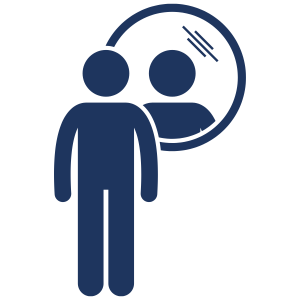
Focus Area 8: Mental Health Basics
1. The Youth Worker’s Role
Youth workers see youth at their best, at their worst, and everything in between. The wide range of behaviors you observe on a daily basis can present challenges, with or without the presence of any underlying mental health issues. And that’s the real difficulty of your role in working with youth – distinguishing whether a behavior is normal, or a symptom of a mental health concern.
In Focus Area 2: Youth Development, you gained a general understanding of what typical or normal developmental behavior for youth looks like at various ages and stages. It’s good to have a frame of reference for those normal developmental behaviors but there’s a potential pitfall to watch out for.
It can be easy to misread or even casually dismiss behavior as normal (e.g. substance experimentation) without considering the opportunity to talk with youth further about it to explore the possibility that it could be a sign of something more serious.
In addition to a frame of reference for normal developmental behavior, you need a frame of reference for distinguishing when a behavior may possibly indicate a mental health issue.
To appreciate just how critical it is that you understand your role in working with youth in the context of mental health, consider this from an article The National Institute of Mental Health (NIH)1 published on the Treatment of Children with Mental Illness:
Research shows that half of all lifetime cases of mental illness begin by age 14. Scientists are discovering that changes in the body leading to mental illness may start much earlier, before any symptoms appear.
Through greater understanding of when and how fast specific areas of children's brains develop, we are learning more about the early stages of a wide range of mental illnesses that appear later in life. Helping young children and their parents manage difficulties early in life may prevent the development of disorders.
Once mental illness develops, it becomes a regular part of your child's behavior and more difficult to treat. Even though we know how to treat (though not yet cure) many disorders, many children with mental illnesses are not getting treatment.
As a youth worker, being able to recognize behaviors that can indicate a mental health struggle and knowing what resources are available and how to access them is vital. This is because there are effective interventions for mental health concerns at every level.
Not knowing the warning signs or what actions you could take to help a youth or family connect to appropriate services could mean that young person or their family suffer unnecessarily.
Know Yourself
Youth workers can play a key supporting role with youth experiencing mental health concerns. If a youth is already seeing a mental health professional, they will welcome the addition of your role. They know that youth will have more positive outcomes when they have strong support in their community.
To be in the best position to support the youth you work with, it’s crucial for you to examine your own motivations and explore your potential biases or misunderstandings about mental health disorders. In short, you’ve got to know yourself to be in the best position to help someone else.
If you’ve ever travelled by air, you’ve probably heard the admonition to “put your own oxygen mask on first.” That’s good advice for youth work in general but it becomes especially meaningful when you are working with youth experiencing mental health challenges.
In learning about Mental Health Basics and beginning to consider how this information can help you better support youth who are facing mental health difficulties, take the time to reflect on the role you will play, as well as your own attitudes and beliefs about mental health.
There are many myths about mental health and it’s possible that you may have some of these beliefs without even realizing it. Please consider this list from the U.S. Department of Health and Human Services2 now and check in on your own understanding:
Myth: Mental health problems don't affect me.
Fact: Mental health problems are actually very common.
In 2014, about:
- One in five American adults experienced a mental health issue
- One in 10 young people experienced a period of major depression
- One in 25 Americans lived with a serious mental illness, such as schizophrenia, bipolar disorder, or major depression.
Suicide is the 10th leading cause of death in the United States. It accounts for the loss of more than 41,000 American lives each year, more than double the number of lives lost to homicide.
Myth: Children don't experience mental health problems.
Fact: Even very young children may show early warning signs of mental health concerns. These mental health problems are often clinically diagnosable, and can be a product of the interaction of biological, psychological, and social factors.
Half of all mental health disorders show first signs before a person turns 14 years old, and three quarters of mental health disorders begin before age 24.
Unfortunately, less than 20% of children and adolescents with diagnosable mental health problems receive the treatment they need. Early mental health support can help a child before problems interfere with other developmental needs.
Myth: People with mental health problems are violent and unpredictable.
Fact: The vast majority of people with mental health problems are no more likely to be violent than anyone else. Most people with mental illness are not violent and only 3%-5% of violent acts can be attributed to individuals living with a serious mental illness.
In fact, people with severe mental illnesses are over 10 times more likely to be victims of violent crime than the general population. You probably know someone with a mental health problem and don't even realize it, because many people with mental health problems are highly active and productive members of our communities.
Myth: People with mental health needs, even those who are managing their mental illness, cannot tolerate the stress of holding down a job.
Fact: People with mental health problems are just as productive as other employees. Employers who hire people with mental health problems report good attendance and punctuality as well as motivation, good work, and job tenure on par with or greater than other employees.
Myth: Personality weakness or character flaws cause mental health problems. People with mental health problems can snap out of it if they try hard enough.
Fact: Mental health problems have nothing to do with being lazy or weak and many people need help to get better. Many factors contribute to mental health problems, including:
- Biological factors, such as genes, physical illness, injury, or brain chemistry
- Life experiences, such as trauma or a history of abuse
- Family history of mental health problems
Myth: There is no hope for people with mental health problems. Once a friend or family member develops mental health problems, they will never recover.
Fact: Studies show that people with mental health problems get better and many completely recover. Recovery refers to the process in which people are able to live, work, learn, and participate fully in their communities. There are more treatments, services, and community support systems than ever before, and they work.
Myth: Therapy and self-help are a waste of time. Why bother when you can just take a pill?
Fact: Treatments for mental health problems vary depending on the individual and could include medication, therapy, or both.
Myth: I can't do anything for a person with a mental health problem.
Fact: Friends and loved ones can make a big difference. Only 44% of adults with diagnosable mental health problems and less than 20% of children and adolescents receive needed treatment. Friends and family can be important influences to help someone get the treatment and services they need.
Myth: Prevention doesn’t work. It is impossible to prevent mental illnesses.
Fact: Prevention of mental, emotional, and behavioral disorders focuses on addressing known risk factors such as exposure to trauma that can affect the chances that children, youth, and young adults will develop mental health problems.
What did you discover?
If you uncovered any bit of bias in your own thinking about mental health issues, or if you discovered that you have been operating with the mistaken belief of a particular myth, no need to judge yourself. Just use the new learning as a baseline to see where you need to improve your knowledge and your skills.




How do I want to show up for youth who are struggling with mental health issues?

What will I do if I start to feel overwhelmed or in over my head?
To get the most benefit from this exercise, challenge yourself to periodically check in as you progress along your youth work career path. Continue to stretch both your thinking and your understanding. Thinking about yourself and your own motivations in this way will help prepare you for all the moments that you can’t even quite anticipate yet.
In addition to thinking ahead, another great way to gain insight about yourself is to spend time reflecting back on your experiences. Here’s an example of one youth worker’s reflection that might shed some light and lessons for you as well:
My first time leading a group of high schoolers to camp, I was only about 19 or 20. I was the lead counselor and so not only was I responsible for the kids having a great time at camp, I was also the head of all the logistics such as collecting money, transportation, keeping an eye on behavior, and so on. I was thrilled to have the responsibility and took it seriously.
One evening during ‘cabin time’ (the more serious discussion part of the day), I decided that I would offer the opportunity for the girls in my cabin to “ask anything.” I wanted the girls to walk away with their questions answered and their concerns heard. As the leader, I thought this was my role. This was a faith-based camp and I was in no way qualified to answer the deep, thoughtful questions of this group of young women. I realized quickly as they started asking questions that I had made a big mistake.
I had way overstepped my role as their camp counselor and taken on the role of a spiritual expert. I learned an important lesson that night. My role had been to allow a space for the girls to express their wonderings and concerns and help them to find their own answers while providing support and a sounding board.
Because I misunderstood my role, the girls not only left without answers, they likely left more confused and frustrated than when they arrived. I was embarrassed and felt exposed, and initially felt like I had failed them.
I later reflected on my mistake and realized how important it is to know my role, set reasonable expectations for myself and seek support and consultation when feeling overwhelmed.
The youth worker who knows themself well is in the best position to be a strong support for others. Know yourself, know your responsibilities, know your abilities as well as the limits of those abilities.
And remember that you are not alone in this – you have a supervisor and colleagues who are ready, willing, and able to step in and help whenever you need them. Additionally, there are resources in the community that you can tap into.
1 NIH “Treatment of Children with Mental Illness.” https://www.nimh.nih.gov/health/publications/treatment-of-children-with-mental-illness-fact-sheet/index.shtml
2 Myths & Facts, US Department of Health & Human Services, MentalHealth.gov website https://www.mentalhealth.gov/basics/mental-health-myths-facts
If you prefer to print this section of The Art & Science of Youth Work certificate course, click on the "Print Friendly" icon to select how you would like it to print. You can remove images and icons.
